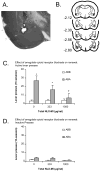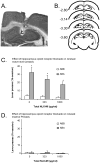Opioid receptors in the basolateral amygdala but not dorsal hippocampus mediate context-induced alcohol seeking
- PMID: 20214927
- PMCID: PMC2884171
- DOI: 10.1016/j.bbr.2010.03.008
Opioid receptors in the basolateral amygdala but not dorsal hippocampus mediate context-induced alcohol seeking
Abstract
Contexts associated with the availability of alcohol can induce craving in humans and alcohol seeking in rats. The opioid antagonist naltrexone attenuates context-induced reinstatement (renewal) of alcohol seeking and suppresses neuronal activation in the basolateral amygdaloid complex and dorsal hippocampus induced by such reinstatement. The objective of this study was to determine whether pharmacological blockade of opioid receptors in the basolateral amygdala or dorsal hippocampus would attenuate the context-induced reinstatement of alcohol seeking. Rats were trained to self-administer alcohol in one context (Context A), extinguished in a distinct context (Context B) and then tested for reinstatement of alcohol seeking in A and B contexts. Prior to the test session, rats were bilaterally microinjected with 0, 333 or 1000ng (total) naloxone methiodide into the basolateral amygdala or dorsal hippocampus. Naloxone methiodide in the amygdala, but not the hippocampus, dose dependently suppressed context-induced reinstatement. This suggests that opioid transmission in the basolateral amygdaloid complex is an important mediator of context-induced alcohol seeking.
Crown Copyright 2010. Published by Elsevier B.V. All rights reserved.
Figures


Similar articles
-
Effects of opioid receptor blockade on the renewal of alcohol seeking induced by context: relationship to c-fos mRNA expression.Eur J Neurosci. 2007 Nov;26(10):2815-23. doi: 10.1111/j.1460-9568.2007.05898.x. Eur J Neurosci. 2007. PMID: 18001278
-
mGluR5 receptors in the basolateral amygdala and nucleus accumbens regulate cue-induced reinstatement of ethanol-seeking behavior.Pharmacol Biochem Behav. 2012 May;101(3):329-35. doi: 10.1016/j.pbb.2012.01.014. Epub 2012 Jan 24. Pharmacol Biochem Behav. 2012. PMID: 22296815 Free PMC article.
-
Effect of selective blockade of mu(1) or delta opioid receptors on reinstatement of alcohol-seeking behavior by drug-associated stimuli in rats.Neuropsychopharmacology. 2002 Sep;27(3):391-9. doi: 10.1016/S0893-133X(02)00302-0. Neuropsychopharmacology. 2002. PMID: 12225696
-
Suppression of ethanol responding by centrally administered CTOP and naltrindole in AA and Wistar rats.Alcohol Clin Exp Res. 2001 Jan;25(1):25-33. doi: 10.1111/j.1530-0277.2001.tb02123.x. Alcohol Clin Exp Res. 2001. PMID: 11198711
-
Review. Context-induced relapse to drug seeking: a review.Philos Trans R Soc Lond B Biol Sci. 2008 Oct 12;363(1507):3233-43. doi: 10.1098/rstb.2008.0090. Philos Trans R Soc Lond B Biol Sci. 2008. PMID: 18640922 Free PMC article. Review.
Cited by
-
Alcohol modulation of G-protein-gated inwardly rectifying potassium channels: from binding to therapeutics.Front Physiol. 2014 Feb 25;5:76. doi: 10.3389/fphys.2014.00076. eCollection 2014. Front Physiol. 2014. PMID: 24611054 Free PMC article. Review.
-
Ethanol-Induced Suppression of G Protein-Gated Inwardly Rectifying K+-Dependent Signaling in the Basal Amygdala.Biol Psychiatry. 2023 Dec 1;94(11):863-874. doi: 10.1016/j.biopsych.2023.04.006. Epub 2023 Apr 15. Biol Psychiatry. 2023. PMID: 37068702 Free PMC article.
-
Learning processes in relapse to alcohol use: lessons from animal models.Psychopharmacology (Berl). 2023 Mar;240(3):393-416. doi: 10.1007/s00213-022-06254-x. Epub 2022 Oct 20. Psychopharmacology (Berl). 2023. PMID: 36264342 Review.
-
Adolescent Alcohol Drinking Renders Adult Drinking BLA-Dependent: BLA Hyper-Activity as Contributor to Comorbid Alcohol Use Disorder and Anxiety Disorders.Brain Sci. 2017 Nov 14;7(11):151. doi: 10.3390/brainsci7110151. Brain Sci. 2017. PMID: 29135933 Free PMC article.
-
The amygdalar opioid system.Handb Behav Neurosci. 2020;26:161-212. doi: 10.1016/B978-0-12-815134-1.00008-8. Epub 2020 Mar 31. Handb Behav Neurosci. 2020. PMID: 34671230 Free PMC article. No abstract available.
References
-
- Anggadiredja K, Sakimura K, Hiranita T, Yamamoto T. Naltrexone attenuates cue- but not drug-induced methamphetamine seeking: a possible mechanism for the dissociation of primary and secondary reward. Brain Res. 2004;1021:272–6. - PubMed
-
- Anton RF, O’Malley SS, Ciraulo DA, Cisler RA, Couper D, Donovan DM, et al. Combined pharmacotherapies and behavioral interventions for alcohol dependence: the COMBINE study: a randomized controlled trial. J Am Med Assoc. 2006;295:2003–17. - PubMed
-
- Bechtholt AJ, Cunningham CL. Ethanol-induced conditioned place preference is expressed through a ventral tegmental area dependent mechanism. Behavioral Neuroscience. 2005;119:213–23. - PubMed
-
- Bianchetti A, Nisato D, Sacilotto R, Dragonetti M, Picerno N, Tarantino A, et al. Quaternary derivatives of narcotic antagonists: stereochemical requirements at the chiral nitrogen for in vitro and in vivo activity. Life Sci. 1983;33 (Suppl 1):415–8. - PubMed
-
- Bossert JM, Poles GC, Sheffler-Collins SI, Ghitza UE. The mGluR2/3 agonist LY379268 attenuates context- and discrete cue-induced reinstatement of sucrose seeking but not sucrose self-administration in rats. Behav Brain Res. 2006;173:148–52. - PubMed
Publication types
MeSH terms
Substances
Grants and funding
LinkOut - more resources
Full Text Sources

